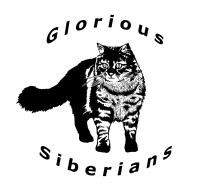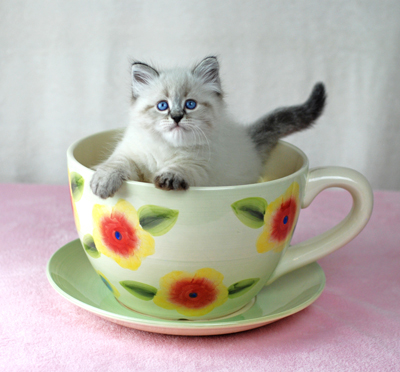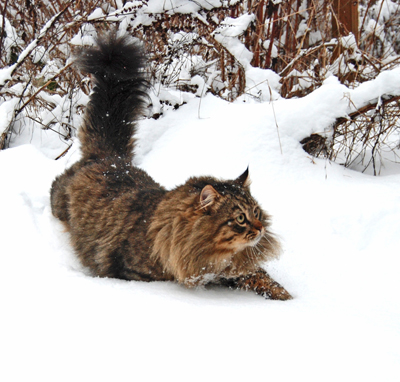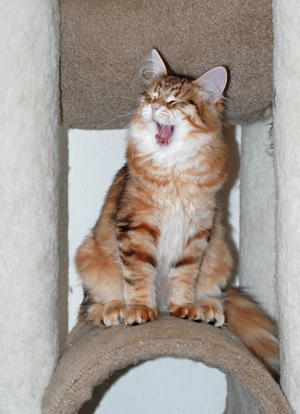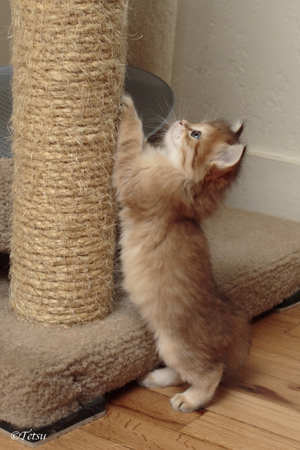What to feed your Siberian The choice of what to feed your Siberian will have an impact on their health both short and long term. With an understanding of how a cat’s digestive system is set up, you will be able to make a wise choice for your companion, who may live 18 years or more. Of course cats are different from us, but how are their food needs different? Here is a comparison:
- People are omnivores, eating and digesting meat, grains, fruits and vegetables.
- Cats are carnivores, consuming and digesting small prey, bones and all. They are not designed to consume grains, cereal, starches, fruits, berries or anything else not originating from another animal. To keep from starving, they may eat things other than their preferred prey.
DRY FOOD Kibble is the most popular choice among cat owners. It can be somewhat less expensive, it is easy to feed especially feeding free choice, and it doesn’t have much of an odor or make much of a mess. Many people, including some veterinarians believe it will help keep a cat’s teeth clean, however this is a myth. When a cat chomps down on dry kibble it shatters and no tooth scrubbing occurs. Additionally, most cats swallow the majority of dry kibble whole. Two important facts:
- Dry kibble must have a good amount of a starch (carbohydrate) source to provide for the structure of the kibble itself.
- Cats are originally desert animals and are designed to obtain about 70% of their moisture (water) needs from their prey.
Cats eating a kibble diet are consuming more carbohydrates (tapioca, potatoes, peas, wheat gluten, maize = corn, etc.) then intended by their natural design. What happens to the excess carbohydrate? Over a few years it tends to make cats overweight and may lead to diabetes or other health issues.
Historically a desert creature, cats are desinged by nature to derive most of their moisture needs directly from their prey/food. Being desert creatures, cats do not have a strong thirst drive. At a point of dehydration where you or I would feel thirsty and start looking for something to drink, a cat would not feel this same need to drink. This lack of thirst goes back to its desert ancestry. Although a cat will drink more water when living on a kibble diet, it won’t drink enough and will be perpetually dehydrated. This continuous, slight dehydration leads to concentrated urine, which sets cats up for: Bladder/Kidney Stones, Cystitis (bladder inflammation), life threatening Urethral Blockage and places the kidneys under more strain than a well hydrated cat.
Clearly, kibble is not a good choice of food when considering the needs of the cat. Glorious Siberian, does not allow kibble to be fed to our Siberians.
CANNED FOOD “A cat’s normal prey contains approximately 70 – 75 percent water. Dry foods only contain 7-10 percent water whereas canned foods contain approximately 78 percent water. Canned foods therefore more closely approximate the natural diet of the cat and are better suited to meet the cat’s water needs.” Lisa A. Pierson, DVM All canned foods contain an appropriate (high) amount of water which is critical for urinary tract health.
- The protein in canned food is more apt to be higher in animal-based protein versus plant-based protein – contrary to most dry foods. You must be diligent and read the ingredient listing.
- The carbohydrate level of most canned foods is lower than that of most dry foods.
Canned food is a much better choice for your Siberian. The composition of different brands of canned foods, and even different flavors within the same brand varies widely. In 2012 Dr. Lisa Pierson provided a list of canned cat foods with their Nutritional Composition broken down into: Protein, Fat, Carbohydrate and Phosphorus. Please see the next article, Canned Cat Food, for a list of canned cat foods with the Protein, Fat, and Carbohydrates percentages available. Dr. Pierson recommends cat food where Protein is greater than Fat, and Carbohydrates are as low as possible.
Eating a variety of foods – words to the wise also applies to your cat’s protein sources as well. Beware of feeding too much fish because ocean fish may be contaminated with mercury, and it can deplete your cat’s thiamin levels. If feeding commercial canned food, shop and offer your Siberian different brands and flavors. Try to identify three different canned foods that your cat enjoys and rotate through them. We also recommend mixing some additional water into the canned cat food so that it resembles a thick stew.
Folks are often a bit too trusting of commercial pet foods. There are numerous recalls of pet foods every year. For the sake of your pets, we suggest that you check the FDA’s recall list at least twice a year. FDA Safety Recalls
RAW MEAT CAT FOOD At Glorious Siberians we fed our own raw meat cat food made with human grade ingredients for the first two years. However, starting in 2015 at the recommendation of our Veterinary Reproductive doctor, we began cooking our homemade food. Our doctor explained that pregnant queens intestinal tracks do not protect the queen by removing as much bad bacteria as a non-pregnant female. It was only recommended that we cook our food, not required. Although we are still big supporters of a Raw Meat Cat Food diet, we now feed a cooked meat diet with commercial canned foods mixed in to vary the flavor.
Cats do best on a grain-free canned or raw diet. In fact, the moisture in these diets may actually help wash away some plaque, rather than allowing it to adhere to teeth. Plaque turns into tartar. Additionally, the enzymes present in raw food may help prevent plaque.
“The diet of the feral top predator will contain almost no carbohydrate, usually less than 2 % by weight. This small amount of carbohydrate will come from seeds and grasses, plus a small amount of muscle glucose consumed with the prey.” From Your Cat: Simple New Secrets to a Longer, Stronger Life, by Elizabeth M. Hodgkins
There are many benefits associated with a raw meat cat food diet:
1. Improved digestion
2. Reduced stool odor and volume
3. Healthy coat, less shedding therefore fewer hairballs
4. Increased energy
5. Natural weight control
6. Better dental health
7. Better urinary health
We understand that you may not have the time or inclination to make your own cat food. Below is a short list of commercial Raw Meat cat foods available:
Balanced Blends Feline’s Pride Nature’s Logic
Primal Formulas Rad Cat Raw Cat Food Bravo
Raw meat cat foods are the closest to what felines were designed to eat. This is also referred to as species specific food.
What about Fruits and Vegetables? Cats lack the digestive enzymes necessary to process raw fruits and vegetables into an efficiently usable form. The idea that cats eat fruits and vegetables by eating the stomach and intestines of their prey is a bit short sighted. It does not take into account the fact that this possible vegetable matter would be pre-digested by the prey’s own enzymes – enzymes that are lacking in the cat. Regardless, the amount of vegetable matter within a bird or mouse would be extremely small, and often a cat doesn’t eat the stomach or intestines.
For more information on this topic including raw cat food recipe: Cat Info .org A helpful article comparing the costs of dry, canned and commercial raw cat foods: Comparison of cat food costs
If you are interested in making Raw Meat cat food for your Siberian, there are two major expenses: 1) Freezer 2) Electric Meat Grinder
The reason you need to grind the meat yourself, is to minimize dangerous bacteria. Pre-ground meat may have significant amounts of bad bacteria. When you buy larger pieces of meat, wash and then grind it yourself, you minimize the amount of bad bacteria. We recommend whole, human grade turkey thigh meat. Remember, pre-ground meat is intended to be cooked to kill bad bacteria.
It costs about $3.50 a pound to make homemade, Raw Meat, or Cooked Meat Cat food.
I purchased my freezer used, off of Craigslist. I purchased my meat grinder on Amazon.com. A decent electric meat grinder starts at around $200, but will only grind meat. Dr. Pieson’s raw meat cat food calls for fresh ground bone. A Glorious Siberian cat owner endorses the Weston 08-1201-W 3/4-HP. Link to Amazon is below. At the time of this posting, cost is $410. According to the owner, “This is an AWESOME grinder!! I use it to grind my turkey thighs, chicken necks etc to make my raw cat food. My smaller Weston was a nightmare…constantly clogging etc. This larger grinder grinds everything with ease, and I don’t have to spend hours pre-cutting and trimming. It has saved me a good 10 hrs each time I make 30 lbs of food. Well worth the investment!! And it is quiet too!!” Weston 08-1201-W 3/4-HP

Weston 08-1201-W 3/4-HP
I have my own recipe for making cat food adapted from Lisa A. Pierson, DVM. Her recipe and in depth instructions are available on line. Dr. Pierson’s Making Raw Meat Cat Food
If you make homemade Cooked Meat cat food, then you may use pre-ground Turkey meat. Often, lower cost human grade ground turkey meat may be found in the frozen food section of the grocery store.
If you purchase a Glorious Siberian, I would be happy to share both the Raw Meat and Cooked Meat cat food recipes with you.
Glorious Siberians requires that you feed a high quality Wet cat food with no grains or cereals.
~~~~~~~~~~~~~~~~~~~~~~~~~~~~~~~~~~~~~~~~~~~~
Dr. Jeannie Thomason, Veterinary Naturopath – “In my opinion, it is no coincidence at all that since 1950, as processed food proliferated for both humans and pets, that not only have cancer rates steadily increased to the highest point in history but, we are seeing an increase in liver disease, diabetes, IBD, chronic skin ailments and other once un-heard of dis-eases in our pets today.
The un-healthy effects of consuming overly cooked food into a digestive system never designed to eat cooked food in the first place, is stretching it to even be considered minimal nutrition.”
“Kibble is Kibble is STILL Kibble,” The Whole Dog
http://www.thewholedog.org/artkibble.html
Elizabeth Hodgkins DVM, JD – “Feline diabetes is not the natural fate of hundreds of thousands of pet cat’s world-wide. It is, rather, a human-created disease that is reaching epidemic proportions because of the highly artificial foods that we have been feeding our feline companions for the past few decades. Without the constant feeding of highly processed, high carbohydrate dry foods, better suited to cattle than cats, adult-onset feline diabetes would be a rare disease, if it occurred at all.” http://www.yourdiabeticcat.com
Dr. Joe Demers, D.V.M – “A reason for overweight pets is what we feed our pet friends. Commercial pet food is anywhere between 45 percent to 65 percent carbohydrates (grains). Grains are the least expensive part of pet food and can fill the animal quickly. Dogs and cats are more carnivores than we humans are, and we are feeding them almost as much grain (or more) than we humans eat. I feel that this high-carbohydrate commercial pet food is the worst food we can feed our pet friends. Our pet friends need fresh meats, not dehydrated meat by-products.”
Dr. T.J. Dunn D.V.M. – “The biggest and most common misconception of all…..the promotion of some low priced grain-based foods as being a “Complete and Balanced” diet for dogs and cats! Having done physical exams on tens of thousands of dogs and cats and learning from their owners what these pets are being fed has taught me that dogs and cats look, feel, and perform better if they are fed a meat-based diet rather than if fed a corn, wheat, soy or rice-based diet.”
Dr. Thomas Londale, D.V.M – “Fat is crucial to carnivores, in maintaining and creating energy, and to produce glycerol. While humans require some carbohydrates for energy and endurance, carnivores need fats, both animal and plant, for creating glucose and developing stamina. Most of the fat used in processed foods can easily go rancid, and need preservatives to help maintain their integrity. Many of these preservatives have been found to be detrimental to the dog’s health and immune systems, most commonly ethoxiquin, BHA and BHT. These can inhibit the production of white blood cells, lower the immune system and block the absorption of glucose. Also lacking in processed foods are the Omega-3 fatty acids, necessary for good coat and skin health. These fats cannot withstand the long shelf life of processed foods.”
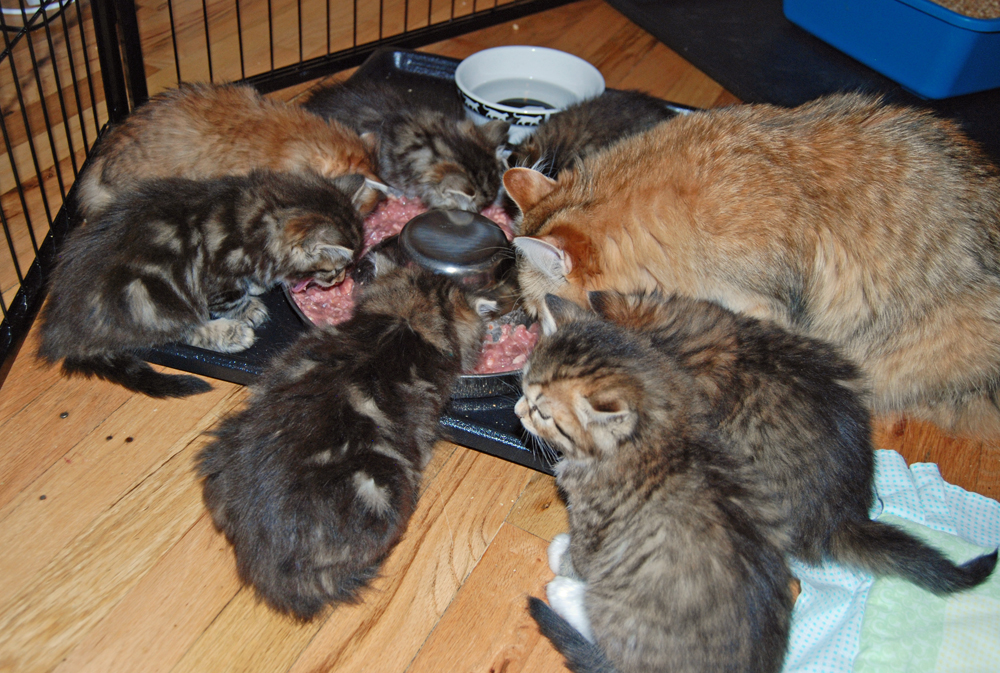
Glorious kittens getting started with raw food.


